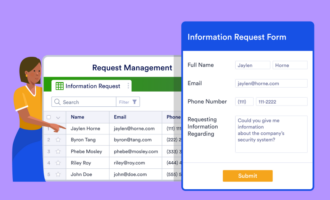5-step workflow checklist
- Identify the workflow owner
- Design the workflow
- Implement the workflow using the right software
- Test the process
- Request feedback
No matter your industry or role, your work is likely stressful enough without adding tedious, manual tasks to the daily grind. When you have strict deadlines and quarterly goals to meet, using inefficient workflow processes only adds to the pressure.
Fortunately, workflow automation — the process of designing a system that streamlines and handles a series of tasks without human intervention — is fairly easy to introduce in your business (especially with the help of a workflow checklist).
By tackling basic everyday tasks automatically — including processing invoices, sending email notifications, tracking marketing campaigns, and managing assets — you’ll save time and money and improve communication, collaboration, visibility, and auditability across your organization. In fact, according to WorkMarket’s 2020 In(Sight) Report, 53 percent of employees and 78 percent of business leaders believe they could save 20 to 30 hours per month with workflow automation.
But you can’t set up workflow automation without proper preparation (and practice). When identifying your first process to automate, it’s important to choose a workflow that meets the following criteria:
- It’s low-pressure: It takes time to work out the kinks in workflow automation, so you want to avoid experimenting on an integral process that keeps your business afloat and instead try automating a lower-stakes workflow to start.
- It has a logical end point: Some people in your organization may resist the changes that come with workflow automation. By choosing a process with an easily discernible outcome — as well as clear benefits — it’ll be much easier for you to persuade any skeptics to adopt automation.
- It involves simple integrations. The more cluttered and complicated a process is, especially if it involves combining different software tools, the more difficult it will be to automate. The process should integrate different software seamlessly.
Now that you’ve selected the process you’d like to improve, here’s a five-step workflow checklist you can follow to prepare it for automation.
1. Identify the workflow owner
Managers are in place at every organizational level for a reason. Each individual manager oversees their department — its workflow steps, goals, expectations, and employees — to get the job done as effectively and efficiently as possible.
So, when automating business processes, you’ll want to put someone with authority in charge who knows the current workflow (including its pros and cons) and how it’s defined. They should be able to answer these questions:
- What’s the current workflow process and the exact outcome of the process? How long does it take from beginning to end?
- What’s the current sequence of steps (including which are optional and which are necessary), and how long does each step take?
- Which employees complete each step?
- What content (documents and media) is currently used to complete the process? Does any of it need modification?
By identifying the workflow owner, you’ll have the insight to build a better, more efficient automated workflow and have someone in place to fix problems if they arise.
2. Design the workflow
Once you have a better understanding of the current business process, the next item on the workflow checklist is to map out a diagram and visualize how it will flow. Keep it as simple as possible, especially if you’re drawing it on paper. Shorter workflows are easier to understand and build on.
By mapping out the process — together with the workflow owner, of course — you’ll see where you can streamline it and fill in gaps.
3. Implement the workflow using the right software
The best way to automate, improve, and modify your workflow processes is with a powerful, easy-to-use, no-code workflow automation system like online form builder Jotform. With its drag-and-drop interface, countless widgets, and 150+ app integrations, Jotform can help you ensure your workflow automation is seamless.
With Jotform’s fully customizable form, PDF, and table templates, you can automate workflows to meet your business needs — whether that’s accepting payments, generating reports, or approving budget or leave requests — no matter your industry.
4. Test the process
Before you go live, it’s important to test your newly automated workflow process to make sure everything is working properly, including conditional paths, formula fields, and overall design. Route all tasks to yourself (or to the workflow owner) to test functionality and accuracy. Then run it several times to ensure it’s consistent.
5. Request feedback
A workflow process is only as good as its results. So, once the automated process has been up and running for a few weeks, the last item on your workflow checklist is to check in with everyone using it to make sure it’s still as simple, accessible, and efficient as the day you implemented it.
By soliciting feedback on what’s working and what’s not, you’re simultaneously building trust and encouraging transparency with your employees, not to mention improving a process that will ultimately make their work lives easier.
Though workflow automation touts plenty of benefits — like speeding up task completion, reducing manual processing errors, and cutting back on labor costs — there’s no denying that it can be a little daunting to implement, especially if your current system seems to be working fine.
But why settle for fine when the pros of automation far outweigh the cons? By following the five steps on this workflow checklist, you’ll successfully automate any workflow — big or small — in no time.
Photo by Laura Olsen on Unsplash














































































Send Comment: